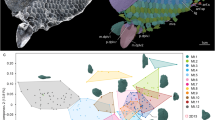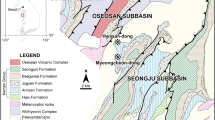Abstract
IN the course of studies of the structure and development of ctenoid scales of certain Indian fishes1, an atypical scale was encountered (see accompanying illustration. It was found on the body of a male Sciœna coitor which measured 20 mm. in length. It was located in the middle region of the trunk on the fifth row below the lateral line. The neighbouring scales and those belonging to the other regions of the body were also critically observed but none of them showed any breach of normal development.
This is a preview of subscription content, access via your institution
Access options
Subscribe to this journal
Receive 51 print issues and online access
$199.00 per year
only $3.90 per issue
Buy this article
- Purchase on Springer Link
- Instant access to full article PDF
Prices may be subject to local taxes which are calculated during checkout
Similar content being viewed by others
References
Ganguly, D. N., and Mookerjee, S., Proc. Nat. Inst. India (in the press).
Author information
Authors and Affiliations
Rights and permissions
About this article
Cite this article
MOOKERJEE, S. An Atypical Scale ofSciaena coitor(Hamilton). Nature 161, 64–65 (1948). https://doi.org/10.1038/161064b0
Issue Date:
DOI: https://doi.org/10.1038/161064b0
This article is cited by
-
On the generic relationship ofBola coitor Hamilton, 1822 (Pisces: Sciaenidae), with a redescription of the species
Proceedings / Indian Academy of Sciences (1971)
Comments
By submitting a comment you agree to abide by our Terms and Community Guidelines. If you find something abusive or that does not comply with our terms or guidelines please flag it as inappropriate.



